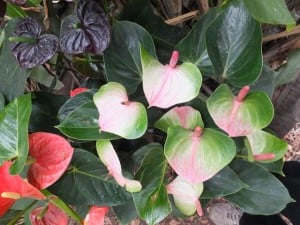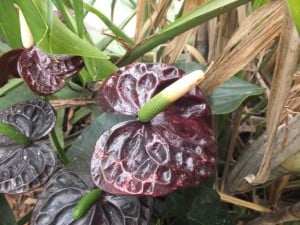
Anthuriums are another gorgeous greenhouse flower that is not really a flower, or rather most of each one is not. These are Araceae or Aroids, tropical versions of our native Lords and Ladies Arums. The flower shaped spathes often glossy and in many flamboyant shades have rod shaped spadix composed of a myriad tiny true flowers.
The most well known species is Anthurium andreanum, the Flamingo Plant or Painter’s palette. Bred in many distinctive forms this now comes with a scarlet, purple, pink, white or variegated spathe and a bright scarlet, or green spadix. The leathery leaves are heart or spear shaped in satiny dark green and quite attractive enough to warrant a place just for their foliage effect.
What is really marvellous is how long a clump stays in ‘bloom’, not days or weeks, but months. It’s not uncommon to have one ‘flower’ spectacularly for nearly half a year, mid-summer till winter, indeed so long dust build-up can became a problem.

Flamingo plants eventually reach up to three feet high and across though more compact in smaller pots with some pruning back. A smaller very similar species is A. scherzerrianum which makes less than two foot each way and stays compact enough to live indoors as a houseplant -though it will not enjoy a hot dry atmosphere.
Anthuriums need humid, even moist but never dank air as long as they are warm enough. They must be kept warm never cold, (never much below 65°F) and if on the cool side then keep them drier or they may get mould. Anthuriums must be watered with warm or at least tepid rain water and never allowed to get either waterlogged or dried out. And Anthuriums do not like strong bright sun needing dappled shade. In other words they need almost exactly the same conditions as Gardenias, indeed I grow mine next to each other.

Anthuriums could be grown from seed but the best varieties need vegetative propagation. Which is easy from offsets so buy a choice selection of small plants and multiply them for friends.
They are particular about their compost. This needs to be really open, gritty, with plenty of broken charcoal, lots of leaf mould and bits of chopped sphagnum moss. The roots tend to creep along the surface as the plant grows and if these appear cover them over, preferably with sphagnum moss.
Anthuriums come from South and Central America, and there more than enough delightful species to satisfy any collector. Maybe ten dozen are or have been in cultivation and many are very attractive with large leaves, some veined, some variegated and some up to five or even seven feet long. A. crystallinum is particularly beautiful with large satiny leaves carrying prominent silver veins. A. watermaliense, Anturio Negro is much prized, found in the Columbian mountains at eight thousand feet this has attractive glossy foliage out of which spring gorgeous quilted coppery black spathes nearly a foot long each with a fat brown spadix. A. pendulifolium ‘Aurea-variegatum’ is a superb hanging basket specimen with hanging, four foot or more long, green leaves with pale yellow to wine red variegation and a violet spadix.


